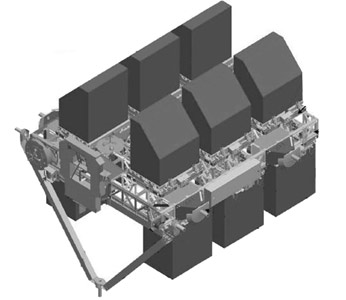Thank you very much for visiting Gunter's Space Page. I hope that this site is useful and informative for you.
If you appreciate the information provided on this site, please consider supporting my work by making a simple and secure donation via PayPal. Please help to run the website and keep everything free of charge. Thank you very much.
ELC 1, 2, 3, 4

ELC [NASA]
The ELC (Expedite the Processing of Experiments to the Space Station (EXPRESS) Logistics Carrier) Logistics Carrier is designed to be carried in the Space Shuttle cargo bay to the International Space Station (ISS), fully integrated with cargo and/or payloads.
Five ELCs were delivered to ISS before Shuttle retirement (FY 2010); four ELCs were to be attached to the starboard truss 3 (S3) and one ELC is attached to the port truss 3 (P3). By attaching at the S3/P3 sites, a variety of views such as zenith (deep space) or nadir (Earthward) direction with a combination of ram (forward) or wake (aft) pointing allows for many possible viewing opportunities.
Each ELC can accommodate 12 Flight Releasable Attachment Mechanism (FRAM)-based cargos which includes two payload attached sites with full avionics accommodation. The mass capacity for an ELC is 4,445 kg with a volume of 30 cubic meters. The ISS provides power to the ELCs through two 3 kW, 120 Vdc feeds at ISS to ELC interface. ELC power distribution module will convert the 120 Vdc power to 120 Vdc and 28 Vdc. Both power voltages will be provided to each payload attached site by separated buses. 120 Vdc power will also be provided to other cargo attached site. Upon installation of the ELCs, it may take up to four hours for the power to be connected.
At the ISS to ELC interface, there are two types of data ports: the High Rate Data Link (HRDL) and the Low Rate Data Link (LRDL). The HRDL uses fiber optics to provide ISS to ELC communication. At the ELC avionics module to Payload interface there are three data ports: HRDL, LRDL and Medium Rate Data Link (MDRL, Ethernet). For uplink MDRL, Ethernet is used; the ELC avionics module will convert the MDRL signal from HDRL interface and delivered to each payload attached site. The transmission rate between ELC avionics module to each payload attached site is no higher than 10 Mbps. For downlink MDRL and HDRL signals, they will be transmitted from payload attached site to ELC avionics module by separated buses. The ELC avionics module will combine these two signals and send to ISS by using HDRL interface. The HDRL downlink service to the ground rate is no higher than 95 Mbps (megabits per second). The LRDL is for a two ways data/command distribution to/from each payload attached site via the ELC avionics module at maximum rate of 1 Mbps.
External camera ports are also available for the ELC payloads. There are at least 14 camera port locations along the trusses that can be used for payload observation.
A fifth ELC was originally planned, but was cancelled and its place was allocated to AMS 02 instead.
| Nation: | USA |
|---|---|
| Type / Application: | Space Station logistic carrier |
| Operator: | NASA |
| Contractors: | |
| Equipment: | |
| Configuration: | |
| Propulsion: | None |
| Power: | via ISS |
| Lifetime: | |
| Mass: | |
| Orbit: | 400 km × 400 km, 51.6° (typical) |
| Satellite | COSPAR | Date | LS | Launch Vehicle | Remarks | |
|---|---|---|---|---|---|---|
| ELC 1 | N/A | 16.11.2009 | CCK LC-39A | Shuttle | with Atlantis F31 (STS-129), ELC 2 | |
| ELC 2 | N/A | 16.11.2009 | CCK LC-39A | Shuttle | with Atlantis F31 (STS 129), ELC 1 | |
| ELC 3 | N/A | 16.05.2011 | CCK LC-39A | Shuttle | with Endeavour F25 (STS 134), AMS 02, STP-H3 | |
| ELC 4 | N/A | 24.02.2011 | CCK LC-39A | Shuttle | with Discovery F39 (STS 133), PMM (Leonardo) | |
| ELC 5 | - | cancelled | CCK LC-39 | Shuttle | with ? |
Pressurized elements:
|
|
Logistics: |
